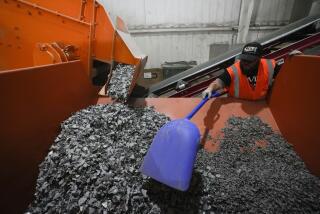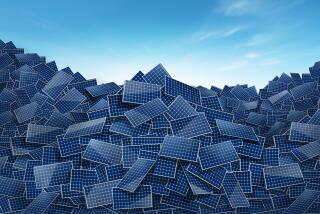In search of a better solar panel
- Share via
In a lab in Caltech, Harry Atwater holds up a plastic panel, a fraction of a millimeter thick. Even in the bright room, the surface’s panel remains jet-black -- absorbing all the light that hits it.
The high-tech material is 10 times more efficient at absorbing light than the regular silicon cells that some homeowners install on their roofs to harvest the energy of the sun.
It is one of several projects that Atwater’s team at Caltech is pursuing in a push to design the next generation of solar cells -- ones that are cheap, long-lasting and flexible enough to be practical for homeowners and businesses.
The idea dates back to 1839, when French physicist Alexandre-Edmond Becquerel discovered that certain materials could produce electric currents when exposed to light. The process, called the photoelectric effect, occurs when electromagnetic radiation (including visible light) is absorbed in a solid, liquid or gas. That energy transfers to electrons, allowing them to escape from their normal positions and flow, to create an electrical current.
Solar cells (solar photovoltaic devices) have been around since the 1950s. Back then, “the costs were astronomical,” said Blake Jones, president of Namaste Solar, a solar electric company based in Colorado.
Improved technology has brought prices far down. And countries such as Japan and Germany have provided subsidies to bring costs down further. In the last year, the U.S. government has done similarly, issuing cash grants to consumers purchasing solar panels and more tax credits for manufacturers of renewable technologies.
Among states, California was the first to kick-start its own solar photovoltaic market by giving consumers tax credits and cash rebates for purchasing solar electric systems. Other states have followed suit. Today, California has the largest market in the U.S., followed by New Jersey and Colorado.
But though homes as well as businesses (including Google, Wal-Mart, and EBay) are increasingly using the technology, solar cells still aren’t as cost-effective as other forms of energy.
The predominant type is a thin wafer made from silicon, the second most abundant element in the Earth’s crust. Silicon-based solar cells have proved to be long-lasting, durable and efficient at converting sunlight into electricity.
However, to be used for solar cells, silicon needs to be purified in an expensive process.
Another type of solar cell is made with the chemical copper indium gallium diselenide or cadmium telluride (far less plentiful in nature than silicon). These materials, though cheaper than silicon, are only half as efficient.
A third type of solar cell uses gallium arsenide, which is capable of absorbing a great deal of light. The material is insensitive to heat, flexible, and resistant to radiation damage -- but very expensive.
Atwater’s Caltech team is trying to design a material that is abundant enough to be cheap and also absorbs a lot of light.
The work has led them toward a new material: a carpet of tiny silicon wires that are embedded in plastic.
The material can absorb 10 times the amount of energy of conventional silicon cells and is also more flexible than a traditional silicon wafer, enabling the panels to more easily coat nonflat surfaces and roofing materials, Atwater said.
The group is also experimenting with other combinations of elements, such as indium gallium phosphide and indium gallum arsenide.
Ultimately, Atwater said, there’s absolutely no reason why solar cells can’t be as cost-effective as other forms of energy. “There are no intrinsic barriers,” he said.
More to Read
Inside the business of entertainment
The Wide Shot brings you news, analysis and insights on everything from streaming wars to production — and what it all means for the future.
You may occasionally receive promotional content from the Los Angeles Times.










